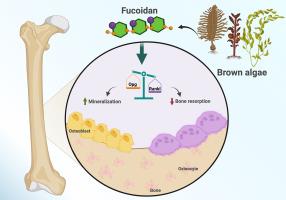三种太平洋褐藻中岩藻胶体外和体外成骨效果的比较。
IF 3.6
2区 医学
Q2 ENDOCRINOLOGY & METABOLISM
引用次数: 0
摘要
褐藻具有生物活性化合物,包括岩藻聚糖,这是一种硫酸盐酸化的多糖,可以根据其来源和组成影响骨细胞。本研究检测了从三种大型藻类(pyrifera Macrocystis, margassum muticum和Undaria pinnatifida)中分离的岩藻聚糖调节骨重塑过程的潜力,并评估了它们的比较效果。在酸性培养基中提取岩藻胶,对其进行化学和结构表征,并比较其在不同阶段骨细胞中的生物活性。岩藻胶以浓度依赖的方式适度降低祖细胞的存活率,表明其对细胞的毒性最小。所有岩藻胶都增强了成骨前细胞MC3T3-E1或小鼠骨髓细胞(BMCs)的矿化,特别是在较高浓度下。低浓度的岩藻胶刺激破骨细胞的形成,高浓度的岩藻胶抑制破骨细胞的形成,这可能是由于基因表达分析表明RANKL/OPG比值的降低。此外,在3D离体颅骨培养中,岩藻多糖以浓度依赖的方式增加了新骨形成面积。虽然这三种岩藻多糖具有相当的生物活性,但羽状海棠的岩藻多糖是最有效的。我们发现海藻中的岩藻胶具有不同浓度的促进骨生长和破骨细胞生成的作用。这些发现表明骨重塑具有双重生物活性,并强调需要进行体内研究以确认其对骨质流失疾病的治疗潜力。本文章由计算机程序翻译,如有差异,请以英文原文为准。

Comparison of in vitro and ex vivo osteogenic efficacy of fucoidans extracted from three brown macroalgae of the Pacific Ocean
Brown macroalgae possesses bioactive compounds including fucoidan, a sulfated polysaccharide that can affect bone cells based on its origin and composition. This study examined the potential of fucoidan isolated from three macroalgal species — Macrocystis pyrifera, Sargassum muticum, and Undaria pinnatifida — to modulate the bone remodeling process and evaluated their comparative effectiveness. Fucoidans were extracted under acidic media, and chemically and structurally characterized before comparing their bioactivity on bone cells at different stages. Fucoidans moderately decreased the survival of progenitor cells in a concentration-dependent manner, demonstrating their minimal toxicity to the cells. All fucoidans enhanced the mineralization of preosteoblast MC3T3-E1 or mouse bone marrow cells (BMCs), particularly at higher concentrations. While low concentrations of fucoidans stimulated osteoclastogenesis, higher concentrations inhibited osteoclast formation which could be due to a reduction in the RANKL/OPG ratio as indicated by gene expression analysis. Furthermore, in a 3D ex vivo calvaria culture, fucoidans increased the new bone formation area in a concentration-dependent manner. Although all three fucoidans showed comparable bioactivities, the fucoidan from U. pinnatifida was the most effective.
We found that fucoidans from marine algae can enhance bone growth and osteoclastogenesis depending on concentration. These findings suggest a dual biological activity in bone remodeling and highlight the need for in vivo studies to confirm their therapeutic potential for bone-loss diseases.
求助全文
通过发布文献求助,成功后即可免费获取论文全文。
去求助
来源期刊

Bone
医学-内分泌学与代谢
CiteScore
8.90
自引率
4.90%
发文量
264
审稿时长
30 days
期刊介绍:
BONE is an interdisciplinary forum for the rapid publication of original articles and reviews on basic, translational, and clinical aspects of bone and mineral metabolism. The Journal also encourages submissions related to interactions of bone with other organ systems, including cartilage, endocrine, muscle, fat, neural, vascular, gastrointestinal, hematopoietic, and immune systems. Particular attention is placed on the application of experimental studies to clinical practice.
 求助内容:
求助内容: 应助结果提醒方式:
应助结果提醒方式:


